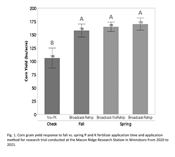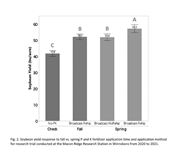Phosphorus And Potassium Fertilizers Application Time Effects Fertilizer Loss And Crop Yield
RASEL PARVEJ
BATON ROUGE, LOUISIANA
Louisiana producers mostly use triple superphosphate (TSP; 0-46-0) for Phosphorus (P) fertilization and muriate of potash (MoP; 0-0-60) for potassium (K) fertilization and apply both fertilizers mostly in the Fall rather than in the Spring. One of the main reasons for fall application is due to wet soil conditions or limited application time in the Spring. However, lots of producers believe that they must apply both TSP and MoP in the Fall since both fertilizers are rocky materials (TSP is originated from phosphate rock and MoP is from potash ore) and require long time to dissolve and become available for plant uptake. Practically, both fertilizers are highly water soluble and can rapidly release nutrients, regardless of application time, when dissolve with adequate soil moisture and/or rainfall/irrigation water. Many studies showed that spring application of both TSP and MoP fertilizers is either equal to or better than fall application in increasing crop yield especially in soils that are deficient and highly prone to nutrient losses via leaching, runoff, and/or erosion.
In 2019-2021, we evaluated the effect of P and K fertilizer application timings on soybean and corn yields at the Macon Ridge Research Station (MRRS) in Winnsboro and Northeast Research Station (NERS) in St. Joseph. These trials were conducted in silt loam soils with 38- or 40-inch-wide bed at both locations. The soil-test P and K concentrations were below the critical level at the MRRS sites but were above the critical level at the NERS. As expected, both corn and soybean yields responded positively to both fall and spring fertilization only at the MRRS sites (Fig. 1-2). Our 2-yr results at the MRRS showed that corn and soybean yields were not significantly different between fall and spring application when P and K fertilizers were broadcasted followed by incorporated by rehipping the bed in the Fall but only broadcasted without rehipping the bed in the Spring.
However, when rehipping was done in the Spring, corn yield was 12 bu/ acre numerically greater and soybean yield was 5 bu/acre statistically greater than fall application. Rehipping in the Spring brought most of the P & K broadcasted in the furrow back to the bed, reduced fertilizer-P and K losses from furrow with rainfall and irrigation water over time, increased fertilizer-P and K availability in the bed near plant roots, and improved P and K uptake and crop yield. Although fall application may help save critical time in the planting season, it reduces available quantity of applied nutrients due to losses through leaching, runoff, erosion, or soil fixation through wet and warm winter, common in Louisiana. The following factors need to be considered in making decision regarding fertilizer application time.
1. The rapidity of P and K fixation to unavailable forms usually increases with the decrease of soil-test P and K concentrations. For example, soils with deficient P and K will fix applied P and K more rapidly than soils with sufficient P and K. Therefore, fertilizers should be applied in the Spring at or near planting in P and K deficient soils to ensure maximum nutrient availabilities during the time of rapid plant uptake.
2. Soil P availability is maximum between soil pH 6.0 and 7.5. Fertilizer-P is fixed to unavailable forms as aluminum phosphate when soil pH falls below 5.5 and as calcium phosphate when soil pH exceeds 7.5. Therefore, fertilizer-P should be applied in the spring as close to planting as possible for fields with low (pH <5.5) or high (pH>7.5) soil pH to ensure maximum fertilizer-P availability for plant uptake.
3. Spring application of fertilizer-P and K should be considered for coarse-textured soils with very low cation exchange capacity (CEC <10) such as loamy sand to sandy loam (sometimes silty loam) soils where nutrient leaching and soil erosion are common, and nutrient deficiencies are often observed.
4. For soils that are very prone to waterlogged/flooded conditions, fertilizer-P and K should be applied in the spring at or near planting since the alternating flooding (anaerobic) and non-flooding (aerobic) conditions decreases soil nutrient availability and increases losses.
5. Fall application of P and K should be considered for soils with nutrient concentration within (medium) or above (sufficient) the critical level, where fertilizers are mainly applied to replace soil nutrients that are removed by harvested grains to maintain the same level of soil nutrient level. In addition, fertilizer-K should be applied in the fall in fields that have long history of chloride (Cl) toxicity problems and are poorly drained. Since K fertilizer (MoP) mainly consists of KCI, fall application will allow enough time to decrease Cl toxicity by reducing Cl accumulation from fertilizer KCl through winter and early spring rainfall. ∆
Rasel Parvej, David Moseley, Matthew Foster, and Rezaul Karim. Louisiana State University AgCenter Scientists

Fig. 1. Corn grain yield response to fall vs. spring P and K fertilizer application time and application method for research trial conducted at the Macon Ridge Research Station in Winnsboro from 2020 to 2021.

Fig. 2. Soybean yield response to fall vs. spring P and K fertilizer application time and application method for research trial conducted at the Macon Ridge Research Station in Winnsboro from 2020 to 2021.